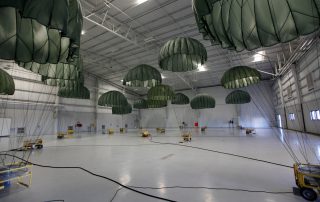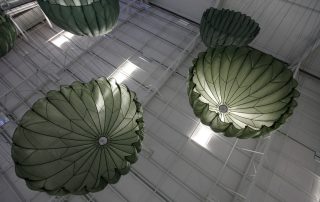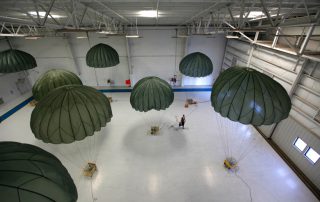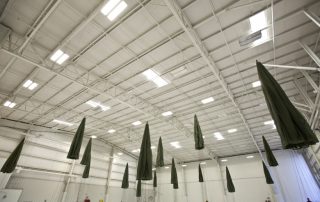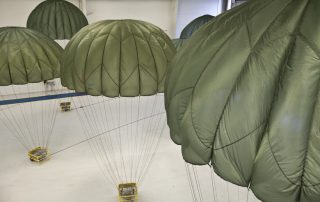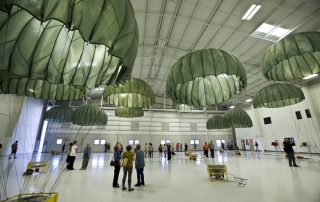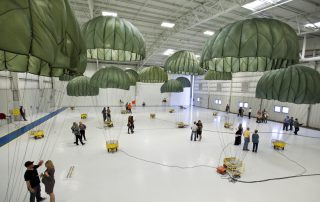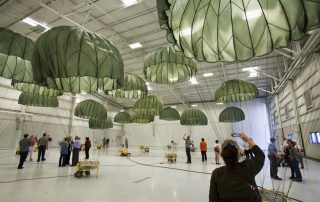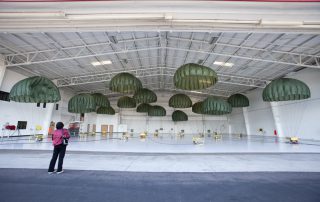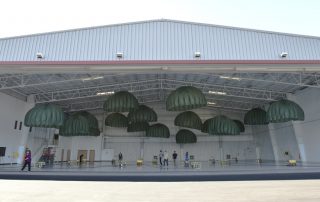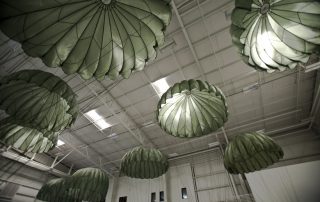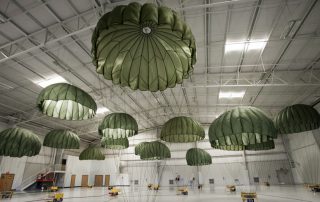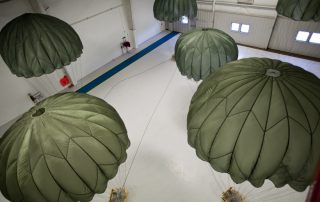17 U.S. Army ‘“ issue reserve parachute canopies (model: T-10R MIRPS-SLCP, color: olive green-107, size: 24-foot diameter), electric fans, parachute cord, carabineers, power cords, external power supply, and airplane hangar
Courtesy of the artist; Labor, Mexico City; and Luciana Brito, São PaoloHéctor Zamora’™s artworks, such as OG-107 Scenery, often exist outside of the museum context. This large-scale installation of 17 inflated parachutes was available for the public to explore on October 27, 2012, at an airplane hangar near the Phoenix Sky Harbor International Airport. This video contains documentation of the day-long installation.’OG-107’ refers to the official olive green color used by the United States military from 1952 until 1989. The 17 parachutes were certified for human use and recently retired from military operations. On an exploratory trip to the Arizona desert, Zamora was startled to hear the boom of tactical bombing practice by F-16 fighter jets. He felt that the military activity and threat of violence, albeit perceived, lay in stark contrast to the isolated, tranquil landscape.OG-107 Scenery is a study in contrasts. Instead of descending from the sky, these parachutes remain aloft, thanks to the air currents generated by the fans. Counteracting the lively dance of the round parachutes (nicknamed ‘jellyfish chutes’ in the military) are the suspension lines restraining them. Although the voluminous canopies reach heights of 35 feet, the imposing airplane hangar both frames and contains them.Claire Carter
Architecture + Art: Héctor Zamora
On view at the Scottsdale Museum of Contemporary Art
October 27, 2012 through January 27, 2013
This exhibition, the third in the museum’™s ‘Architecture + Art’ series, includes two works commissioned by SMoCA, Reductio Ad Absurdum and OG-107 Scenery. Héctor Zamora was attracted to Phoenix, in part, by the opportunity to work in a city struggling with urban sprawl, yet surrounded by a raw and sparsely populated landscape. On a week-long research visit in October 2011, Zamora explored the crippling impact of the U.S. housing collapse on Arizona’™s new building construction and population growth, as well as the vast presence of the United States military infrastructure spread across the state.
Héctor Zamora is a truly international artist: born in Mexico, he resides in Brazil, and makes artwork all over the world. During the past decade, Zamora has completed large-scale architectural installations in both museums and public spaces in 21 countries on five continents. His work sets up radical juxtapositions’”sand pouring from an abandoned travel trailer; fifteen tons of bananas stuffed into a fifth-floor apartment in Columbia; nine trees suspended over a blighted, polluted river. The unexpected contrasts raise awareness of divisions, such as disputed territory, public and private space, cultural boundaries, economic privilege and poverty. In his projects, Zamora pries into political structures and often challenges the limits of physical materials, laborious construction, even the municipal laws of the places in which he is working.
